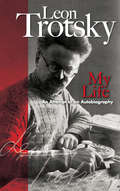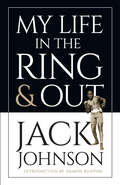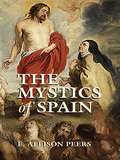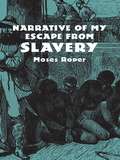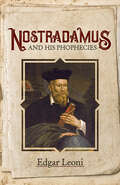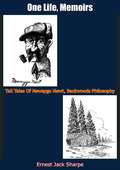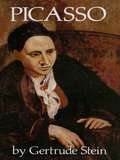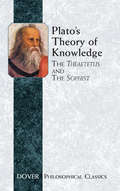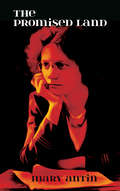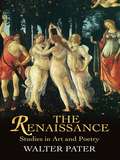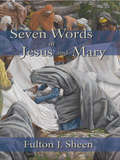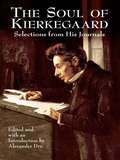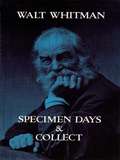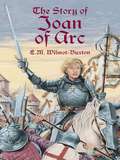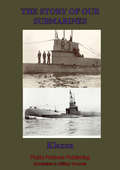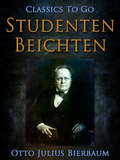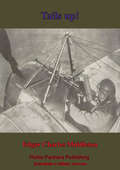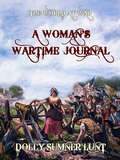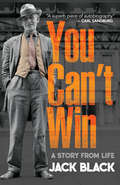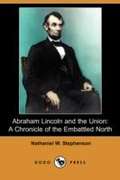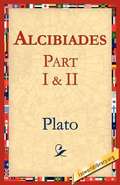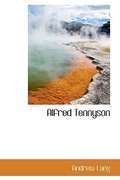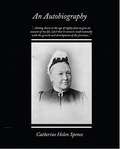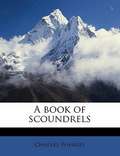- Table View
- List View
My Life: An Attempt at an Autobiography
by Leon TrotskyThe only Bolshevik leader to write his memoirs, Leon Trotsky published this remarkable book in 1930, the first year of a perilous, decade-long exile that ended with his assassination in Mexico. Expelled from the Communist party and deported from the Soviet Union, the former People's Commissar for Foreign Affairs recalled his lifelong struggle in the world of revolutionary politics. In addition to his firsthand accounts of the early intrigues within the Communist government, Trotsky also delivered chilling glimpses into the rise of the new Soviet bureaucracy and prescient warnings of the Stalinist regime's horrors.My Life recounts the rise of the revolutionary wave in Russia in 1905 and 1917, the devastating effects of World War I, and the degeneration of the Russian Revolution from Lenin's internationalist course to Stalin's increasingly counterrevolutionary policies. Trotsky's exile placed him beyond the pale of both the official Communist party and the rest of the political world; yet in this fascinating historical document, he remains true to a philosophy of permanent world revolution, offering a highly informed perspective on the struggle toward a socialist future.
My Life in the Ring and Out
by Jack JohnsonThe first African American to win the world heavyweight championship, Jack Johnson (1878–1946) was the preeminent American sports personality of his era. Holder of the title from 1908 to 1915, Johnson continued to box professionally until he was in his 60s. His 1910 victory over the formerly undefeated champion James J. Jeffries in "The Fight of the Century" triggered race riots across the country, and racial bias fueled the clamor for his defeat by a "Great White Hope." Johnson was a cultural lightning rod whose professional success and lavish lifestyle attracted both admiration and envy. In this witty and sophisticated memoir, he recounts without bitterness the prejudice, controversies, and scandals that dogged his public and private lives. Johnson was well known for his exploits beyond the boxing world, and he offers vivid accounts of his international adventures as a bullfighter, race car driver, cabaret entertainer, and spy. His outrageous feats include rescuing a passenger train from murderous bandits in Mexico, chasing a kangaroo across the Australian outback, walking away from five fiery car crashes, and surviving revolutions in Spain, Brazil, Cuba, and elsewhere. The only edition of Johnson's autobiography currently in print, this volume features 16 full-page illustrations and an introductory article by Damon Runyon.
The Mystics of Spain
by E. Allison PeersDuring the sixteenth century -- the golden age of Spanish mysticism -- Roman Catholicism produced a thoroughly orthodox form of mysticism, a type of meditation that lay at the core of religious beliefs and was practiced to raise spiritual consciousness. In this authoritative book, a leading specialist in the field presents a comprehensive, ground-breaking study of the works and personalities of fifteen mystical authors. A brief exploration of the period serves as a background to extracts from the authors' writings.Included are Juan de Ávila and his "Letter to a religious, urging him to the perfect love of God"; St. Teresa of Jesus and her "An exclamation of the soul to God"; and St. John of the Cross, represented in part by his best-known work, "Dark Night of the Soul." The text also contains "A contemplation to obtain love" by St. Ignatius of Loyola, as well as the meditations of Alonso de Orozco, Luis de Granada, Diego de Estella, Luis de León, and Pedro Malón de Chaide, among others. A list of books is provided for those who wish to make this anthology a starting point for further study.
Narrative of My Escape from Slavery
by Moses RoperThis 1838 autobiography ranks among the most important and authentic accounts of life in slavery, recounting the experiences of a North Carolina native who was sold or traded until his successful escape to New England. Roper's moving reminiscences offer a powerful first-hand account of the realities of life in bondage. Introduction.
Nostradamus and His Prophecies (Dover Occult Ser.)
by Edgar LeoniFor over 400 years the prophecies of the controversial French prophet Michel Nostradamus (1503-66) have fascinated people because they project far into the future (A.D. 3797), and because they are open to countless interpretations. Until the publication of this book, however, there was no truly complete translation of the prophecies with even the minimum of scholarly apparatus required. Edgar Leoni’s comprehensive, definitive study not only fills that gap but goes far beyond.This edition includes parallel texts in English and French of all Nostradamus’s prophecies (arranged in then "centuries," or collections of 100 rhymed quatrains). Also included are explanatory notes, a series of indexes, historical background to the prophecies, a Commentary section, including the most famous — and infamous — interpretations; a critical biography of Nostradamus, his will and personal letters, and bibliographical material on both Nostradamus and his commentators.
Picasso
by Gertrude SteinFor more than a generation, Gertrude Stein's Paris home at 27 rue de Fleurus was the center of a glittering coterie of artists and writers, one of whom was Pablo Picasso. In this intimate and revealing memoir, Stein tells us much about the great man (and herself) and offers many insights into the life and art of the 20th century's greatest painter.Mixing biological fact with artistic and aesthetic comments, she limns a unique portrait of Picasso as a founder of Cubism, an intimate of Appollinaire, Max Jacob, Braque, Derain, and others, and a genius driven by a ceaseless quest to convey his vision of the 20th century. We learn, for example, of the importance of his native Spain in shaping Picasso's approach to art; of the influence of calligraphy and African sculpture; of his profound struggle to remain true to his own vision; of the overriding need to empty himself of the forms and ideas that welled up within him.Stein's close relationship with Picasso furnishes her with a unique vantage point in composing this perceptive and provocative reminiscence. It will delight any admirer of Picasso or Gertrude Stein; it is indispensable to an understanding of modern art.
Plato's Theory of Knowledge: The Theaetetus and the Sophist (Dover Philosophical Classics Ser.)
by Plato Francis M. CornfordTranslated by the noted classical scholar Francis M. Cornford, this edition of two masterpieces of Plato's later period features extensive ongoing commentaries by Cornford that provide helpful background information and valuable insights. Both works pose eternal questions that keep these dialogs ever-relevant not only for students of philosophy but also for every reader and thinker. The Theatetus offers a systematic treatment of the question, "What is knowledge?" Most of the dialog takes place between Socrates and the student Theatetus. Among the answers they explore: knowledge as perception; knowledge as true belief; knowledge as true belief plus an account (i.e., a justified true belief); as well as variations on each of these answers. Like most Socratic dialogs, the Theatetus ends without a definitive answer — leaving the subject open for the reader's further consideration. In the Sophist, a related dialog, Plato redefines the term "sophist," which hitherto had connoted one who gives sophia (wisdom) to his disciples. Plato depreciated the term, and ever since, in philosophy, sophistry indicates the deceptive exploitation of linguistic ambiguities. The dialog follows Socrates' cross-examination of a self-proclaimed true philosopher, The Stranger, on the distinction between philosophers, statesmen, and sophists.
The Promised Land
by Mary Antin"A unique contribution to our modern literature and to our modern history." — The New York TimesThis classic of the Jewish-American immigrant experience was an instant critical and popular success upon its 1912 publication. Author Mary Antin arrived in the United States from Russia in the 1890s at the age of 12. Her memoir vividly recaptures scenes from both Old and New World cultures, chronicling the poverty and oppression of Czarist Russia as well as the excitement and challenges of her assimilation into American life at the turn of the twentieth century.Although she arrived without knowing a word of English, Antin wholeheartedly embraced her new home. "A kingdom in the slums," her Boston neighborhood afforded freedom and intellectual riches in the forms of a secular education, public library, and cultural activities at the local settlement house. This moving narrative articulates Antin's dreams as well as her stark realities, offering modern readers authentic and enduring perspectives of immigrant life.
The Renaissance: Studies in Art and Poetry (Dover Fine Art, History Of Art Series)
by Walter PaterPublished to equal parts scandal and acclaim in 1873, The Renaissance inspired a generation of Oxford undergraduates, who adapted its credo of "arts for art's sake" for their Aesthetic Movement. Combining the skepticism of empirical philosophy, the materialism of 19th-century science, and the determinism of evolutionary theory, this book defies categorization and endures as an innovative example of cultural criticism.An Oxford don who led a quiet scholarly life, Walter Pater was shocked at the reactions his writings provoked. ("I wish they would not call me a hedonist," he remarked, "it gives such a wrong impression to those who do not know Greek.") His essays on the individuals he viewed as embodiments of the Renaissance spirit encompass artists whose careers span the Middle Ages through the 18th century. Pater's elegant, fluid prose examines the works of Pico della Mirandola, Leonardo, Michelangelo, Botticelli, and others. He crowns his compendium of reflections with his notorious Conclusion, in which he asserts that "to burn always with this hard, gemlike flame, to maintain this ecstasy, is success in life."One of Victorian England's most talked about books, The Renaissance exerted a crucial influence on the art criticism of the past century, and it remains a work of unusual importance to those interested in art history and English literature.
Seven Words of Jesus and Mary
by Fulton J. SheenFulton J. Sheen turned his voice and pen to many subjects during the course of a long and remarkable apostolate. But nothing was closer to the heart of his message than bringing the words of Our Lord and Our Blessed Mother to bear on the problems of modern life and the modern world. In this book, Archbishop Sheen explores the connection between the seven words spoken by Mary in the Gospels, and the seven last words of Jesus on the Cross. Fulton Sheen was unparalleled in his ability to combine theology, devotion, and the profoundest reflections on the central events of the Christian narrative. Displayed here in full are the literary and rhetorical skills of one of the greatest preachers of the 20th century. Sheen's meditations will slake the spiritual thirst of all who desire a fuller understanding of the Gospels and seek to draw closer to Christ and Mary.
The Soul of Kierkegaard: Selections from His Journals
by Alexander Dru Søren KierkegaardDenmark's foremost philosopher and religious writer, Søren Kierkegaard (1813-1855) maintained a journal throughout his adult life that amounted to more than 7,000 pages of alternative drafts of published works, biographical events, musings, and outpourings. A precursor of the Existential movement and a major influence on modern Protestant theology, Kierkegaard confided to his journal further reflections on the ideas developed in his philosophical and theological works, and on his tumultuous career as an author.
Specimen Days & Collect
by Walt WhitmanPublished in 1882, Whitman's uniquely revealing impressions of the people, places, and events of his time, principally the Civil War era and its aftermath, offer a rare excursion into the mind and heart of one of America's greatest poets. His intimate observations and reflections have profoundly deepened understanding of 19th-century American life.
The Story of Joan of Arc
by E. M. Wilmot-BuxtonInspiring story of a 15th-century farm girl who answered a divine call to drive the English from France. The miraculous story of the Maid of Orleans unfolds from her early childhood and the touching story of the "Voices," to the battles she led and the splendid march to Rheims.
The Story Of Our Submarines
by KlaxonThe classic Submarine story by Klaxon "The Story of our Submarines" is a gem to ad to any collection.
Studenten-Beichten
by Otto Julius BierbaumOriginell und zeitlos erzählt Bierbaum Anekdoten und Erlebnisse aus seiner Zeit als Student. Eine kunterbunte Sammlung unterhaltender Literatur. Inhalt: Neuer Widmungsbrief an Richard Dehmel. Letzte Musterung Josephine Die erste Mensur Waschermadlhistorie Die Mondmarie Der Negerkomiker Selbstzucht To-lu-to-lo oder Wie Emil Türke wurde Leberecht der Gestrenge Zwei Äpfel Die falsche Kindbetterin
Tails Up!
by Colonel John Buchan Edgar Charles MiddletonThe battle in the air above the trenches has held an enduring fascination for generations; the plane itself was only a new development when the First World War started and the pioneers sought to gain any advantage in the skies over their opponents. Edgar Middleton wrote copiously on the subject as well as active air service was involved with the Aeronautical Institute of Great Britain, in this book he records in sketches and anecdotes the reality of the air-war.The author was a well-respected and long-serving war correspondent of the air war for such papers and magazines as Cassell’s Magazine, Daily Chronicle, Daily Express, Evening News, Flying, New York Sun, and The Star.Author — Middleton, Edgar Charles, 1894-1939.Foreword— Colonel Buchan, John, 1875-1940.Text taken, whole and complete, from the edition published in London: Simpkin, Marshall, Hamilton, Kent, 1918Original Page Count – 314 pages
A Woman's Wartime Journal: An Account Of The Passage Over A Georgia Plantation Of Shermans Army On The March To The Sea (1918) (The World At War)
by Dolly Lunt(Excerpt) "Though Southern rural life has necessarily changed since the Civil War, I doubt that there is in the entire South a place where it has changed less than on the Burge Plantation, near Covington, Georgia. And I do not know in the whole country a place that I should rather see again in springtime - the Georgia springtime, when the air is like a tonic vapor distilled from the earth, from pine trees, tulip trees, balm-of-Gilead trees (or "bam" trees, as the negroes call them), blossoming Judas trees, Georgia crab-apple, dogwood pink and white, peach blossom, wistaria, sweet-shrub, dog violets, pansy violets, Cherokee roses, wild honeysuckle, azalea, and the evanescent green of new treetops, all carried in solution in the sunlight. It is indicative of the fidelity of the plantation to its old traditions that though more than threescore springs have come and gone since Sherman and his army crossed the red cotton fields surrounding the plantation house, and though the Burge family name died out, many years ago, with Mrs. Thomas Burge, a portion of whose wartime journal makes up the body of this book, the place continues to be known by her name and her husband's, as it was when they resided there before the Civil War. Some of the negroes mentioned in the journal still live in cabins on the plantation, and almost all the younger generation are the children or grandchildren of Mrs. Burge's former slaves."
You Can't Win: A Story from Life
by Jack BlackA major influence on William S. Burroughs and other Beat writers, this memoir by a drifter and small-time criminal recaptures a hobo world of hopping trains, burglaries, prison, and drug addiction.
Abraham Lincoln
by James Russell LowellWhen Lincoln took office as President of the United States, the nation was fraught with problems, not the least of which was slavery and the danger of secession. This biography relates how Lincoln dealt with the problems with thought and wisdom.
Alcibiades II
by PlatoThe Second Alcibiades or Alcibiades II (Greek: Ἀλκιβιάδης βʹ) is a dialogue traditionally ascribed to Plato. In it, Socrates attempts to persuade Alcibiades that it is unsafe for him to pray to the gods if he does not know whether what he prays for is actually good or bad for him. <P> <P> There is dispute amongst scholars about the text's authenticity, and it is generally considered apocryphal.[1] The main criticisms of its authenticity revolve around its defective arguments, lack of humor, and style; those who consider it inauthentic date its composition to the 3rd or 2nd centuries BCE.
Alfred Tennyson
by Andrew LangINTRODUCTION. IN writing this brief sketch of the Life of Tennyson, and this attempt to appreciate his work, I have rested almost entirely on the Bio- graphy by Lord Tennyson with his kind per- mission and on the text of the Poems. <P> <P> As to the Life, doubtless current anecdotes, not given in the Biography, are known to me, and to most people. But as they must also be familiar to the author of the Biography, I have not thought it desirable to include what he rejected. The works of the localisers I liave not read Tennyson disliked these researches, as a rule, and they appear to be unessential, and often hazardous. The professed commentators I have not consulted. It appeared better to give ones own impressions of the Poems, unaffected by the impressions of others, except in one or two cases where matters of fact rather than of taste seemed to be in question. Thus on two or three points I have ventured to differ from a distinguished living critic, and have given the reasons for my dissent. . .
An Autobiography
by Catherine Helen SpenceSitting down at the age of eighty-four to give an account of my life, I feel that it connects itself naturally with the growth and development of the province of South Australia, to which I came with my family in the year 1839, before it was quite three years old. <P> <P> But there is much truth in Wordsworth's line, "the child is father of the man," and no less is the mother of the woman; and I must go back to Scotland for the roots of my character and Ideals. I account myself well-born, for My father and my mother loved each other. I consider myself well descended, going back for many generations on both sides of intelligent and respectable people. I think I was well brought up, for my father and mother were of one mind regarding the care of the family. I count myself well educated, for the admirable woman at the head of the school which I attended from the age of four and a half till I was thirteen and a half, was a born teacher in advance of her own times. In fact. like my own dear mother, Sarah Phin was a New Woman without knowing it. The phrase was not known in the thirties
A Book of Scoundrels
by Charles WhibleyWhile murder is wellnigh as old as life, property and the pocket invented theft, late-born among the arts. It was not until avarice had devised many a cunning trick for the protection of wealth, until civilisation had multiplied the forms of portable property, that thieving became a liberal and an elegant profession.
